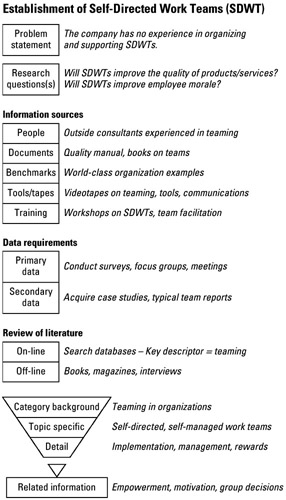Tool 98: Information Needs Analysis
| AKA | N/A |
| Classification | Data Collecting (DC) |
Tool description
An information needs analysis allows the researcher to quickly check to see what information is available and what information needs to be researched. A systematic flow directs the researcher to consider various information sources and the data collection methods to be used.
Typical application
-
To identify information needs for implementing a particular project.
-
To acquire knowledge through applied research methods.
-
To determine what information is needed to begin a problem-solving effort.
Problem-solving phase
| → | Select and define problem or opportunity |
| → | Identify and analyze causes or potential change |
| → | Develop and plan possible solutions or change |
| Implement and evaluate solution or change | |
| Measure and report solution or change results | |
| Recognize and reward team efforts |
Typically used by
| 2 | Research/statistics |
| Creativity/innovation | |
| Engineering | |
| Project management | |
| Manufacturing | |
| Marketing/sales | |
| Administration/documentation | |
| Servicing/support | |
| Customer/quality metrics | |
| 1 | Change management |
before
-
Data collection strategy
-
Surveying
-
Questionnaires
-
Sampling Methods
-
Thematic content analysis
after
-
Project planning log
-
Interview technique
-
Customer needs table
-
Process analysis
-
Problem analysis
Notes and key points
-
Recommendation: All libraries have an information handout for completing a review of literature using local equipment and catalog-access information. Ask for this information and save time.
Step-by-step procedure
-
STEP 1 The first step requires the development of a problem statement to direct the information needs analysis to a specific area or category. See example Establishment of Self-Directed Work Teams (SDWT).
-
STEP 2 From the problem statements, two or three research questions are stated to further focus on information needs.
-
STEP 3 Using the information needs analysis flow diagram, the following information sources are considered, as shown in the example:
-
Information sources
-
Data requirements
-
Review of literature
-
Related information
-
-
STEP 4 Next, specific research and data collection assignments are allocated to all team participants.
-
STEP 5 Finally, all information is sorted and reviewed.
Example of tool application

EAN: 2147483647
Pages: 326